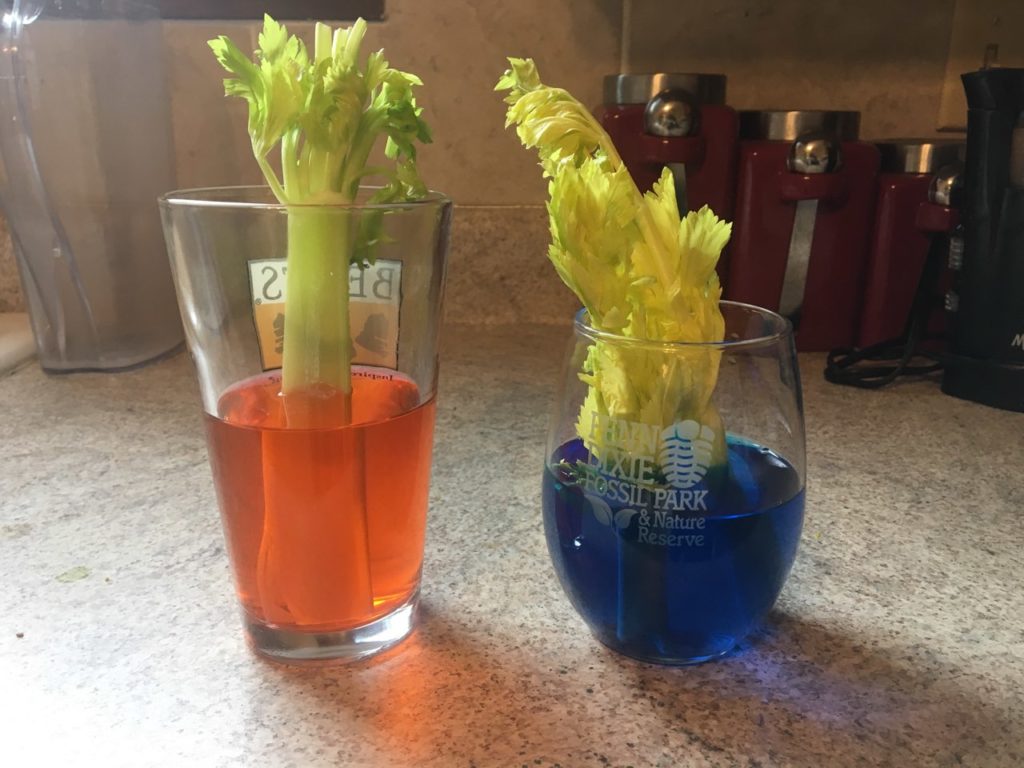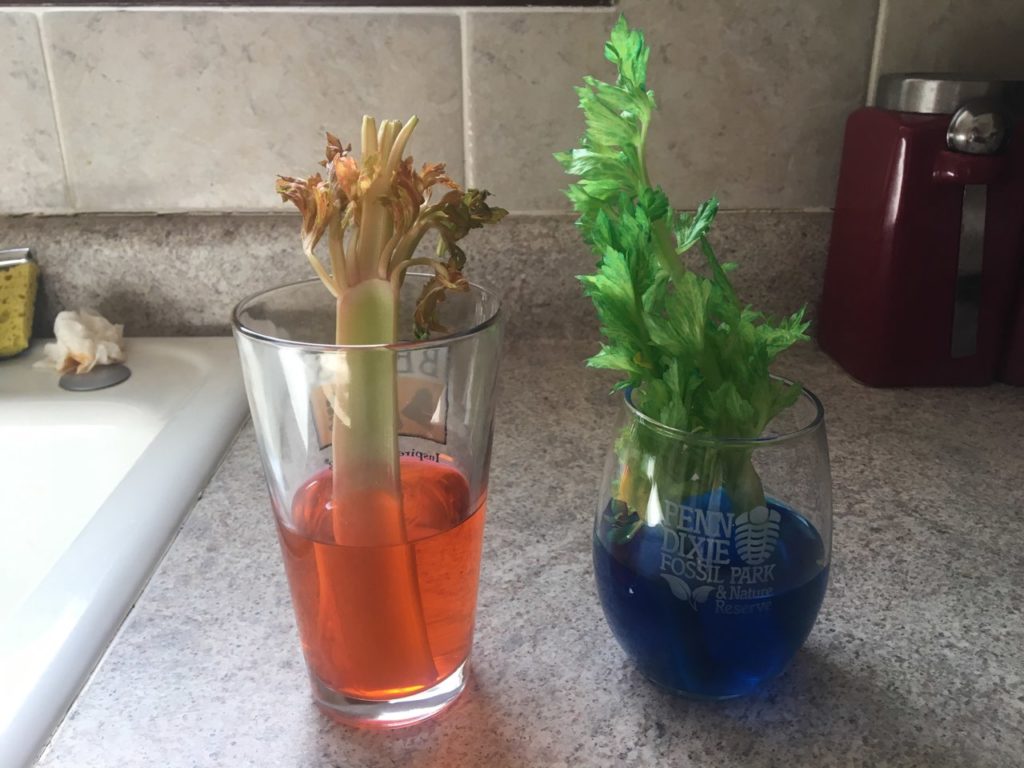Written by:
Yanna Shimanskaya
Matthew Cato
Materials:
Celery stalks (keep the leaves on!) / Lettuce is a good alternative
Spoon
Knife
Large clear cup(s)
Measuring cup
Water
Food coloring (Darker colors tend to perform better, like blue or red)
Patience
Length:
Set up → 5 minutes
Actual experiment → 10 minutes
Results → Wait at least 24 hours
Learning Goal Objective/s:
Children will measure the appropriate amount of water into their cup.
Children will identify the colors of the rainbow as they select which colors they want their celery stick to absorb.
Children will accurately count how many drops of food coloring they squeeze into their cup.
Children will discuss their predictions and observations.
Academic Subject(s):
Science- This lesson supports: preschool to third grade Greetings!
This special “Sanity Saver” blog entry is based on the Living Lab project originally planned to be implemented with our visitors in Spring of 2020.
The Living Lab is a collaborative project between UB’s Early Childhood Research Center (ECRC) and Explore & More – The Ralph C. Wilson, Jr. Children’s Museum. The Living Lab is designed to bring child development research and knowledge directly to you through play-like experiments with your child! In each of the Living Lab sessions, UB graduate student researchers would engage your child in a brief and play-like experiment based on cutting-edge research. They would then explain to you the purpose of the experiment and why it is important. In addition, they would provide some fun activities and ideas for you to try at home to facilitate your child’s learning and development.
Since all in-person activities are on hold the ECRC and E&M partnered together to still be able to reach you in your living room! The UB student researchers have created fun and engaging activities based on their research experiments. We hope you will try them out.
As Explore & More’s community partner, ECRC also welcomes you to check out its online resources and activities for young children (ages 2-6) and their parents and caregivers: https://www.facebook.com/EarlyChildhoodResearchCenter.
What is Causal Explanatory Reasoning? A fundamental task for all humans is to explain why and how things happen. Causal explanatory reasoning, or the process of identifying cause and effect, allows children to grasp an understanding of the world around them. Causal knowledge allows children to create predictions, engage in efficacious interventions, and provide explanations to frequently asked questions about ways in which the world works.
The Celery Experiment: This activity is an oldie, but a goodie! The color-changing-celery-stalk science experiment can help young learners better understand plant growth and how plants soak up their nutrients in order to survive and thrive. Aside from engaging in a fun and colorful activity, children will be able to visualize a cause and effect relationship as the experiment demonstrates and explains how plants absorb necessary nutrients. Caregivers may encourage their child(ren) to create predictions, share their observations, and provide their own conclusions as they carry out and discover this exciting representation of the exchanges that occur between plants and nutrients. Who knew something as simple as celery stalks could allow children to realize and appreciate how plants “eat and drink” in the real world?
Directions:
1. Caregiver-Preparation: Separate celery stalks and cut the white bottoms off of the stalk(s). Select a piece of celery that has the most leaves on the top, because a lot of the soaked up food coloring will show up in the leaves. Don’t hesitate to create this experiment with multiple cups of color-changing celery! It could be fun to see which colors from your food coloring selection will affect the celery stalks differently.
2. Introduce terms such as nutrients and absorption.
To gain a better perspective of your child’s current understanding of plant-life, feel free to ask open-ended questions (such as: how do you think plants grow? Or what do you think plants need in order to survive and why?)
Explain that your child will be able to see how a plant soaks up nutrients through this colorful activity!
Also notify your child that once they complete the activity, they will have to wait one full day to see any results.
3. Ask your child(ren) to fill the cup(s) up using a measuring cup. Depending on the size of the large cup, measurements can vary. Use enough water to fill the cup halfway. Depending on the age and abilities of your child, you may need to provide hand-over-hand assistance
4. Tell your child(ren) to select and identify their desired food coloring color
5. Encourage your child to squeeze at least 10 drops of food coloring into the water cup. Depending on your child, you may want to guide him/her in either counting, squeezing the drops into the water, or both.
6. Stir water and food coloring mixture with a spoon.
7. Place one celery stalk into the cup
8. At this point, you can ask your child what predictions he/she is making. Example: What do you think is going to happen to the celery stick now that the water is a different color?
9. Activity is now complete! Wait at least a full day in order to see the results.
10. Put the experiment on display (on a windowsill) or in a safe place to prevent spills. Encourage your child to check in on the experiments to see if there will be any continuous changes to the celery sticks. In order to keep track of the experiment, your child can be encouraged to periodically draw their observations in a notebook.
11. After about 24 hours, explore and discover what has happened to the celery stick and the water. Feel free to dissect the celery stick by breaking it in half, cutting it down the middle, and tearing the leaves apart.
12. Conclude the experiment by revisiting which observations have been stated and then ask your child about the experiment by using open-ended, “THINK” questions that require the child to think about possibilities, try out predication, etc.: What would happen if…? * How did…? * Why is…? * Why do you think…? (Example: Why did the water change color? What if you added more drops/different colors? How would it change your celery stick? How was the celery stick affected?).
13. Once you and your child(ren) have completed this experiment, relate the newfound knowledge to their natural surroundings. For example, next time you and your child are outside, try to find a flower/plant and recall the experiment to explain that plants in nature survive and grow by soaking up nutrients. For example, next time it rains, prompt a discussion about plant absorption and plant growth while revisiting your findings during the experiment.
Vocabulary Words:
Absorb: take in or soak up (energy or a liquid or other substance) by chemical or physical action.
Nutrients: a substance that provides nourishment essential for growth and the maintenance of life.
Growth:the process of increasing in physical size.


